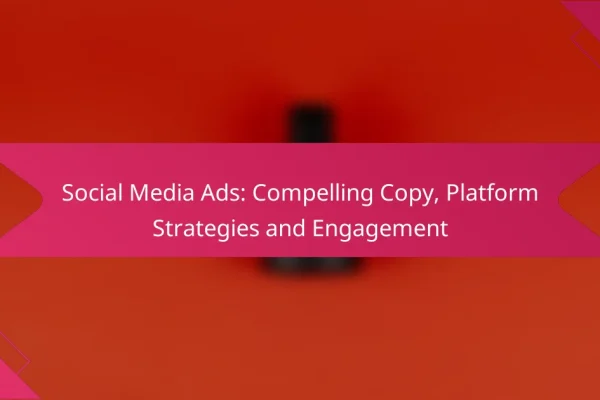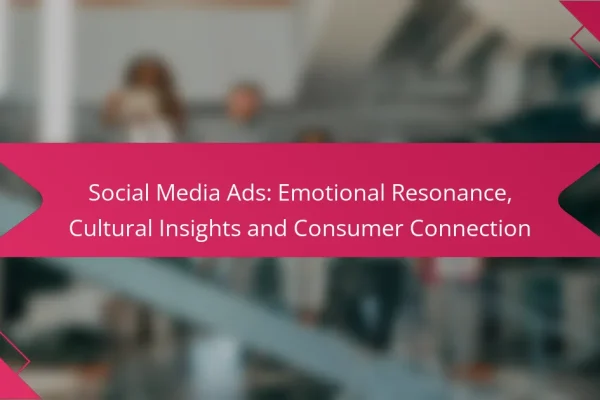What are effective strategies for social media ad creative development?
Effective strategies for social media ad creative development focus on engaging visuals, authentic content, and a strong brand presence. By combining these elements with data insights and continuous testing, advertisers can create compelling ads that resonate with their target audience.
Visual storytelling techniques
Visual storytelling techniques involve using images, videos, and graphics to convey a narrative that captures attention. This approach can include using a sequence of images to show a product in use or creating a short video that illustrates a brand’s mission. Aim for a clear, relatable story that aligns with your audience’s interests and emotions.
Consider using bold visuals and minimal text to enhance impact. For instance, a vibrant image of a product in a real-life setting can be more effective than a generic stock photo. Use colors and styles that reflect your brand identity to create a cohesive look across your ads.
Utilizing user-generated content
User-generated content (UGC) is a powerful way to build trust and authenticity in your ads. By featuring content created by your customers, such as photos or testimonials, you can showcase real experiences with your brand. This not only engages your audience but also encourages others to share their experiences.
To effectively use UGC, encourage customers to tag your brand on social media and create a branded hashtag. This can help you gather content easily and foster community engagement. Always seek permission before using someone else’s content to avoid copyright issues.
Incorporating brand identity
Incorporating brand identity in your ad creatives ensures consistency and recognition across platforms. This includes using your brand colors, fonts, and logos in all visuals. A strong brand identity helps your audience immediately recognize your ads, which can improve recall and engagement.
Additionally, ensure that your messaging aligns with your brand values and voice. For example, if your brand promotes sustainability, highlight eco-friendly practices in your ads. This alignment reinforces your brand’s credibility and strengthens customer loyalty.
Leveraging data-driven insights
Leveraging data-driven insights involves analyzing performance metrics to inform your ad creative decisions. Use analytics tools to track engagement rates, click-through rates, and conversion metrics. This information can help you understand what resonates with your audience and what needs improvement.
Focus on A/B testing different ad variations to see which elements perform best. For instance, test different headlines, images, or calls to action to determine what drives the most engagement. Use these insights to refine your creative strategy continuously.
Testing and optimizing creatives
Testing and optimizing creatives is crucial for maximizing ad performance. Regularly review your ad campaigns to identify which creatives are underperforming and why. This could involve adjusting visuals, copy, or targeting strategies based on audience feedback and performance data.
Implement a systematic approach to testing, such as running small-scale tests before a full launch. Monitor results closely and be prepared to make quick adjustments. This iterative process can significantly enhance the effectiveness of your social media ads over time.
How can businesses in the US enhance their ad creatives?
Businesses in the US can enhance their ad creatives by focusing on local trends, utilizing culturally relevant imagery, and actively engaging with community feedback. These strategies help create more relatable and effective advertisements that resonate with target audiences.
Adapting to local trends
To effectively adapt to local trends, businesses should stay informed about current events, popular culture, and regional preferences. This can involve monitoring social media, local news, and community discussions to identify what resonates with audiences.
For example, a restaurant chain might highlight seasonal ingredients or local events in their ads, making them more appealing to the community. Regularly updating ad creatives to reflect these trends can significantly boost engagement rates.
Using culturally relevant imagery
Incorporating culturally relevant imagery is crucial for connecting with diverse audiences. Businesses should select visuals that reflect the demographics and values of their target market, ensuring that the imagery resonates authentically.
For instance, a clothing brand targeting a multicultural audience might showcase models from various backgrounds wearing their products. This not only promotes inclusivity but also enhances the relatability of the ad, leading to a stronger emotional connection with viewers.
Engaging with community feedback
Engaging with community feedback allows businesses to refine their ad creatives based on real customer insights. Encouraging comments and reviews on social media can provide valuable information about what works and what doesn’t.
Companies can conduct surveys or polls to gather opinions on ad concepts before launching them. This proactive approach not only improves ad effectiveness but also fosters a sense of community involvement, making customers feel valued and heard.
What tools are available for developing social media ad creatives?
Several tools can help create effective social media ad creatives, each catering to different needs and skill levels. From design to scheduling, these tools streamline the process and enhance the quality of your ads.
Canva for design
Canva is a user-friendly graphic design tool ideal for creating social media ads quickly. It offers a vast library of templates, images, and fonts, making it accessible for beginners and professionals alike.
When using Canva, consider the dimensions required for each social media platform, as they vary significantly. For instance, Instagram posts typically require a square format, while Facebook ads may need a horizontal layout.
Adobe Creative Cloud for advanced editing
Adobe Creative Cloud provides powerful tools like Photoshop and Illustrator for more advanced editing and design capabilities. These applications allow for intricate designs, photo manipulation, and vector graphics, suitable for brands looking to create unique and high-quality visuals.
While Adobe tools offer extensive features, they come with a steeper learning curve and a subscription cost. Brands should weigh the benefits of professional-grade design against the time and investment required to master these tools.
Hootsuite for scheduling and analytics
Hootsuite is a comprehensive social media management platform that allows users to schedule posts and analyze performance across multiple channels. This tool is essential for ensuring timely ad placements and monitoring engagement metrics.
Utilizing Hootsuite can help brands optimize their ad campaigns by identifying peak engagement times and adjusting strategies accordingly. Regularly reviewing analytics can inform future creative development and improve overall ad effectiveness.
What are the key elements of a successful social media ad?
A successful social media ad typically includes compelling headlines, clear calls-to-action, and high-quality visuals. These elements work together to capture attention, drive engagement, and encourage conversions.
Compelling headlines
Compelling headlines are crucial for grabbing the audience’s attention in a crowded social media feed. They should be concise, engaging, and relevant to the target audience’s interests or needs.
Consider using action verbs, posing questions, or highlighting benefits to make your headlines stand out. For example, instead of “New Shoes Available,” try “Step Up Your Style with Our New Shoe Collection!”
Clear call-to-action
A clear call-to-action (CTA) directs users on what to do next, whether it’s to shop now, sign up, or learn more. Effective CTAs are specific, actionable, and create a sense of urgency.
Use phrases like “Get Yours Today” or “Join the Movement” to motivate users. Avoid vague language; instead, be direct and clear about the desired action.
High-quality visuals
High-quality visuals are essential for making your social media ads visually appealing and memorable. Use sharp images, engaging videos, or eye-catching graphics that align with your brand identity.
Ensure that visuals are optimized for the platform you are using, considering dimensions and formats. For instance, Instagram favors square images, while Facebook supports both landscape and portrait formats. Consistent branding across visuals helps reinforce recognition and trust.
What metrics should be tracked for ad creative performance?
Tracking the right metrics is essential for evaluating the performance of social media ad creatives. Key metrics include click-through rates, conversion rates, and engagement metrics, each providing insights into different aspects of ad effectiveness.
Click-through rates
Click-through rate (CTR) measures the percentage of users who click on an ad after seeing it. A higher CTR indicates that the ad creative is compelling and relevant to the target audience. Generally, a CTR of 1-3% is considered average, while rates above 3% are seen as strong.
To improve CTR, focus on creating eye-catching visuals and clear calls to action. A/B testing different ad formats and messaging can help identify what resonates best with your audience.
Conversion rates
Conversion rate refers to the percentage of users who complete a desired action after clicking on an ad, such as making a purchase or signing up for a newsletter. This metric is crucial for assessing the effectiveness of the ad in driving actual business results. Typical conversion rates range from 2-5%, but this can vary widely by industry.
To enhance conversion rates, ensure that the landing page aligns with the ad’s message and offers a seamless user experience. Consider using retargeting strategies to re-engage users who showed interest but did not convert.
Engagement metrics
Engagement metrics include likes, shares, comments, and overall interactions with the ad. These metrics provide insight into how well the ad resonates with the audience and can indicate brand awareness and affinity. High engagement often correlates with a strong connection to the audience.
To boost engagement, create content that encourages interaction, such as polls or questions. Monitoring engagement can help refine future ad creatives to better align with audience preferences and behaviors.
What are the prerequisites for effective ad creative development?
Effective ad creative development requires a clear understanding of your target audience and the platforms where the ads will be displayed. This foundation helps in crafting messages that resonate and engage effectively.
Understanding your target audience
Knowing your target audience is crucial for creating compelling ad creatives. This involves researching demographics, preferences, and behaviors to tailor your message accordingly. Utilize tools like surveys, social media insights, and analytics to gather relevant data.
For example, if your audience is primarily young adults aged 18-24, consider using vibrant visuals and trending topics that appeal to their interests. Understanding their pain points can also guide your messaging to address their specific needs.
Choosing the right platform
Selecting the appropriate social media platform is essential for effective ad creative development. Each platform has unique characteristics and user demographics that influence how your ad will be received. For instance, Instagram is visually driven, while LinkedIn caters to a professional audience.
Evaluate where your audience spends their time and tailor your creatives to fit the platform’s format. For example, short videos may perform well on TikTok, while detailed articles might be better suited for Facebook or LinkedIn.
Setting clear objectives
Establishing clear objectives is a key step in the ad creative development process. Determine what you want to achieve with your ads, whether it’s brand awareness, lead generation, or sales conversions. Having specific goals helps in measuring success and refining your approach.
For instance, if your goal is to increase website traffic, your ad creative should include a strong call-to-action that directs users to your site. Use metrics like click-through rates and conversion rates to assess the effectiveness of your campaigns.
Budget considerations
Budgeting is a critical aspect of ad creative development. Determine how much you are willing to spend on ad placements and creative production. This will influence the quality of your creatives and the reach of your campaigns.
Consider allocating a portion of your budget for A/B testing different creatives to see which performs best. This can help optimize your spending and improve overall campaign effectiveness.












